|
BY ARTHUR NOXON |
This work begins with a review of the present relationship between audio and television. Then we jump towards the future where high end audio mixes with television in the home theater. To that end, we study subwoofers, their behavior and relationships to the listening room.
OUR HERITAGE
One would think that the advent of video tape players would have automatically moved things forward for television audio. Not so, as evidenced by the abundance of players with mono audio outputs and the sparsity of hi-fi grade audio bandwidths, not to mention real stereo/hifi outputs. Sophistication in video signal processing for tape players far exceeded any investment into the audio channel.
Manufacturers, salespeople, and consumers of television systems have developed a long-standing tradition that sound is a minor, relatively insignificant component of the television experience. One might compare the standard television sound system of today to the portable record player of the '50s. They both have small speakers positioned in empty, openbacked cabinets and are driven by noisy signal detectors through very limited bandwidth amplifiers. It's as if early television adopted for its voice the common audio of its day. And then, as time went by, television resisted any change in its audio, as if by claiming that if it was good enough then, it's good enough now.
Possibly the hottest improvement in television audio is stereo TV. Now we get to have two four-inch speakers in an open-back plastic cabinet, one speaker on each side of the screen. Beyond this, there is a new problem. The stereo created image overlays on the TV screen only for the person sitting directly on the centerline of the set. For the rest of us who sit slightly to the side, the sound falls off the screen, to the nearest speaker. In the world of high end audio, there has been a lot of very hard work to achieve a wide "sweet spot" so that the image continues to float between the speakers, even though the listener moves off dead center. They don't use two four-inch speakers, three feet apart and separated by a glass plate.
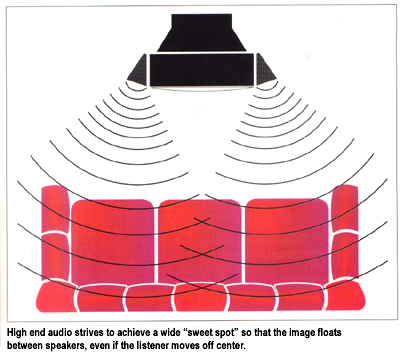 And now we
have home
theater, the hottest, most rapidly expanding market outside of home
computers. We have TV stores opening up home theater rooms in order to
stay in business. We have hi-fi stores opening up home theater rooms to
stay in business. And we have a whole new kind of store opening up,
which exclusively service the home theater business. High definition
television is being enjoined with high fidelity audio in a new kind of
system called home theater.
And now we
have home
theater, the hottest, most rapidly expanding market outside of home
computers. We have TV stores opening up home theater rooms in order to
stay in business. We have hi-fi stores opening up home theater rooms to
stay in business. And we have a whole new kind of store opening up,
which exclusively service the home theater business. High definition
television is being enjoined with high fidelity audio in a new kind of
system called home theater.
Unfortunately, this exciting technical evolution takes place within the context of traditional television performance values. This tags audio as having no more than a bit part in the show, when, in fact, it is the audio track that plays the lead part in home theater. And so, those of us who work with and enjoy home theater are faced with a major problem -- reorientation. We need to expect more from home theater than we are used to getting from present-day TV. Home theater offers the combined effects of high end audio systems, high fidelity surround sound tape players, and high definition TV. We need to learn to expect more from the performance in home theater than we have ever gotten from our TV sets of the past.
SUBWOOFERS
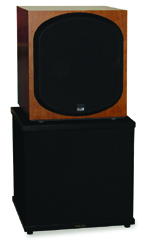 It's
well-known in
high end audio that to achieve full potential, the last link in the
audio chain has to be properly set up. Audio, like any other chain,
cannot be stronger than its weakest link. For modern audio systems, the
weakest link is also the last link, the listening room. That's why the
opportunities for setting up the home theater room mean more than just
the equipment. It means the room acoustics as well. Setting up a room
includes the positioning of the loudspeakers, and no speaker is more
sensitive to room acoustics than the subwoofer. And so, in the upcoming
section, we will begin to study the relationships that exist between
the position of the subwoofer and the room.
It's
well-known in
high end audio that to achieve full potential, the last link in the
audio chain has to be properly set up. Audio, like any other chain,
cannot be stronger than its weakest link. For modern audio systems, the
weakest link is also the last link, the listening room. That's why the
opportunities for setting up the home theater room mean more than just
the equipment. It means the room acoustics as well. Setting up a room
includes the positioning of the loudspeakers, and no speaker is more
sensitive to room acoustics than the subwoofer. And so, in the upcoming
section, we will begin to study the relationships that exist between
the position of the subwoofer and the room.
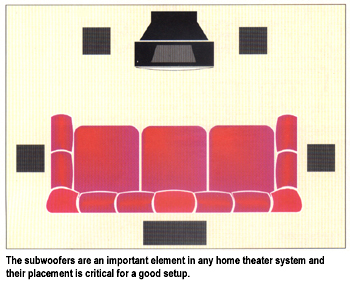 The home
theater
audio system includes subwoofers, main dialogue speakers, and surround
speakers. The very least playback system should be sort of like a
five-channel sat/sub system - one sub, three dialogue, and two ambience
speakers. The higher end home theater systems sport two or three subs,
full-range speakers for dialogue, and special bipole speakers for
ambience. No matter what the system, subwoofers are an important
element in the complement of speakers needed to present home theater
audio. Placement of subs within the room is critical in the setup of a
good room.
The home
theater
audio system includes subwoofers, main dialogue speakers, and surround
speakers. The very least playback system should be sort of like a
five-channel sat/sub system - one sub, three dialogue, and two ambience
speakers. The higher end home theater systems sport two or three subs,
full-range speakers for dialogue, and special bipole speakers for
ambience. No matter what the system, subwoofers are an important
element in the complement of speakers needed to present home theater
audio. Placement of subs within the room is critical in the setup of a
good room.
ROOM MODES
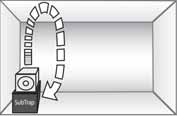 The most common enemy
of subwoofers is room modes. A room mode is the organized way that
sound is stored in a room. An organ pipe becomes stimulated into
resonance when a thin sheet of air is blown across a hole at the bottom
of the pipe. That resonance, called a pipe mode, sounds great. A
listening room, like the organ pipe, is an acoustic chamber that can be
stimulated into resonance -- but this time it's done by the air pumping
action of the subwoofer. Room modes cause the subwoofer to sound very
loud for one note, and fairly quiet for another.
The most common enemy
of subwoofers is room modes. A room mode is the organized way that
sound is stored in a room. An organ pipe becomes stimulated into
resonance when a thin sheet of air is blown across a hole at the bottom
of the pipe. That resonance, called a pipe mode, sounds great. A
listening room, like the organ pipe, is an acoustic chamber that can be
stimulated into resonance -- but this time it's done by the air pumping
action of the subwoofer. Room modes cause the subwoofer to sound very
loud for one note, and fairly quiet for another.
In the scientific study of room modes, there has developed a very unique type of room, a reverberation chamber. This room is designed for the testing of sound absorbing materials. A good reverb chamber has very thick, slick, and heavy walls. Sound is stored for a long time in such chambers. If you shouted in one of these rooms, you would hear your voice echoing around for 15 to 20 seconds.
There is a measure for how well sound is stored in rooms. It is called the RT-60 and seconds are the units of measurement. RT means reverb time and the 60 stands for 60 dB. RT-60 means the time it takes for the sound to die away over a range of 60 dB. The dB, of course, is decibel, the unit of sound loudness. It is no coincidence that the range of 60 dB corresponds to the range of loudness between a shout and a barely audible whisper.
The loudspeaker that drives the reverb chamber is traditionally located tight into a corner of the room and for good reason. The corner of a room is the single most efficient place to locate a low frequency driver for the development of room modes. The speaker can stimulate more resonances from the corner of the room than it can if located in any other part of the room. This has to do with the efficiency aspect of how speakers couple to room modes.
There is another, somewhat significant, reason that the speaker is located in the tricorner of the reverb chamber; it is the "horn loading" effect of the tricorner walls. There is no news in this concept as nearly all musical instruments have a similar but higher efficiency exponential type horn which couples their sound generating system to the air of the room into which they play. Can you recall listening to someone playing nothing more than a tuba mouthpiece? It isn't very interesting at all. But plug that same mouthpiece into a spiral wrapped, exponential horn and that noise is turned into beautiful sounds.
For the purposes of testing sound absorbing materials, the acoustical engineers want to stimulate as many room modes as possible. They also want the mode tones to be as evenly spaced along the frequency scale.
This is not too strange. For example, the notes of the musical scale are very evenly spaced. There happens to be particular ratios of room dimensions that promote evenly spaced modes. This only holds true if the speaker remains located in the tricorner of the room.
If the speaker is moved away from the corner, only some of the modes are able to be coupled to the speaker and their spacing becomes anything but uniform. The "golden ratios" for room dimensions are only good if the speaker is located in the tricorner of the room. Almost no one listens to a good stereo with speakers located in the corners of the room. So, on a practical basis and especially for high end audio, where speakers are carefully positioned away from the corners, these golden room ratios serve little or no functional purpose.
One of the more popular tales in the folklore of high end audio stems from a basic misunderstanding of the purpose and limitations of reverb chamber design. Reverb chamber ratios are all too often quoted as being "ideal" room dimension ratios because they will "smooth out the bass." Home theater does have some roots in high end audio and this tale will eventually begin to circulate in the world of home theater. It is important for those of us who work at and enjoy quality audio to avoid being charmed by magic numbers, unless, of course, they work.
STANDING WAVES
Bass traps (low frequency sound absorbers), room modes, room dimensions, subwoofers, and their placement are all intertwined into one composite instrument that generates sound and delivers it to the room where it is heard by the listener. Unlike the tuba, where the instrument is in one place and the listener is in another, the subwoofer/ room system is so large that it literally engulfs the listener. This explains an old saying in audio, "For bass, the listener is not really listening to the speaker, but rather, listening to the room as it is being played by the speaker."
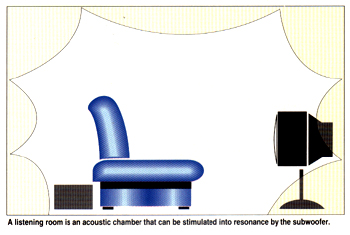 One of the
most
enlightening experiences found in exploring the behavior of subwoofers
in rooms is witnessing the effects of standing waves, otherwise known
as a room resonance or mode. We have been studying about modes from the
outside. Next, we dive into the interior of the standing wave. The
first problem we will have is setting up a method to generate standing
waves. Probably it is easiest to simply leave a security deposit with
your favorite high end shop and borrow the signal generator from their
repair department. Be sure to have someone show you how to feed the
signal into your preamp.
One of the
most
enlightening experiences found in exploring the behavior of subwoofers
in rooms is witnessing the effects of standing waves, otherwise known
as a room resonance or mode. We have been studying about modes from the
outside. Next, we dive into the interior of the standing wave. The
first problem we will have is setting up a method to generate standing
waves. Probably it is easiest to simply leave a security deposit with
your favorite high end shop and borrow the signal generator from their
repair department. Be sure to have someone show you how to feed the
signal into your preamp.
Use one channel and one speaker for these tests because there is nothing but confusion to be gained by using two speakers. Move a subwoofer into one comer of your room and put a Radio Shack sound meter in any other corner, on the floor. String out the signal generator so you can operate it and still watch the dB needle of the sound level meter. The meter should be set at 80 dB and on "fast" and "C-weighted" for best results. Start with the lowest frequency at about 20 Hz. Slowly raise the tone of the generator and watch the meter. You may have to change meter scale settings or adjust the speaker volume to get the needle to stay somewhat on scale. As you raise the frequency, you are performing a frequency sweep. You can sweep up or down the frequency scale.
Often, the first sweep range of the signal generator will be 20 to 200 Hz. This contains for all practical purposes the entire bass range. And it's the only range you'll need for subwoofers as they are usually rolled off at about 85 Hz. For more fun, you can raise the roll off point of the sub to its highest value, about 150 Hz. Then use the frequency sweep controls of the signal generator and watch the needle of the sound level meter rise and fall as you change frequencies. Remember as you do this that the speaker volume control is not being touched, only the tone is changing. Despite the constant power to the speaker, you will see the sound levels in the corner of the room rise and fall as much as 15 dB between adjacent peaks and valleys.
Adjust the signal generator so as to choose a peak, in the 50 to 60 Hz region. Then get up and slowly walk around the room, noticing the peaks and valleys of sound that have filled the room. Next, pick up and carry the sound meter to observe the strength of the peaks compared to the strength of the valleys as you again move around the room. Move to your listening chair and sit. Locate the sound level near your ear and compare the reading there with those elsewhere in the room. Hold the sound meter at arm's length and slowly wave it around while keeping an eye on the meter. The indicator needle of the meter will rise and fall with position. However, if you move too quickly, the meter will begin to pick up the sound of the air rustle and your readings will become polluted with noise.
By now, you are beginning to really understand that some bass. tones can be much louder than others. And further, that any particular tone can sound louder or quieter, depending on where you might be sitting. Although we didn't explore one other variation, it doesn't take much imagination to expect that if we sat still and moved the speaker, again we would hear peaks and valleys as it is dragged about the room. You could put the subwoofer on a furniture dolly and have someone pull it out of the corner and across the room while you sit and listen to the build up and fall of sound as the speaker moves in and out of efficient coupling zones.
Our hearing of bass is so sensitive that you can actually hear someone else walking across the room. Dial in a resonance at about 100 to 115 Hz. Find a spot in the room where there is almost no sound. It's called a "suck out" for some unknown reason. Find it and stay there. Then have someone slowly walk around the room. You will hear the strength of the sound field come and go as the person moves. Use the meter to measure this sound level shifting. It's as if the room was nearly filled with large balloons; and, as the person walked around, these balloons were shoved aside, circulating out of the way. You could detect the movement as it shifts the positions of a few nearby balloons. You can even hear if someone opens or closes a door, as if the balloons fell out of the room.
All of this discussion about room modes is applicable, due to the fact that the typical listening room is fairly small. If you move the speaker and listening test onto the sand dunes, there will be no reflections and no modes. Put the speaker in a deep forest, and there will be many reflections off the big trees, but still no modes. Put the speaker in a huge hall or even a normal-sized movie theater and still, no modes to speak of.
Only small rooms have room modes and only small rooms sound like they have room modes. This remains one of the biggest problems in high end audio and home theater systems. Wonderful audio tracks played over great electronics and speakers are reduced to overwhelming boom and mud, due to the coupling of speakers to the various small room modes. So, what do we do about this inevitable mess? Well, we certainly don't want to place the speaker in some position that stimulates all of the room modes, whether they are evenly spaced or not. Our needs are not that of the acoustical testing engineer. For high end and home theater audio playback, we want the subwoofer to be located preferably so that it couples not to some, but actually none of the room modes.
On one hand, we have the science of acoustics which
gives us a set of magic numbers that enable a cornerloaded speaker to
efficiently couple to all possible modes in a room and even more, have
the modes spaced as evenly as possible. It should be no surprise that
this same science can give another set of magic numbers, one that
prevents the speaker from efficiently coupling to create the room
modes. It is only those magic numbers which can create the anti-mode
type, high end audio, and home theater room setups that we are really
interested in knowing about and working with. Next time, we will study
the anti-mode method of speaker placement.
On one hand, we have the science of acoustics which
gives us a set of magic numbers that enable a cornerloaded speaker to
efficiently couple to all possible modes in a room and even more, have
the modes spaced as evenly as possible. It should be no surprise that
this same science can give another set of magic numbers, one that
prevents the speaker from efficiently coupling to create the room
modes. It is only those magic numbers which can create the anti-mode
type, high end audio, and home theater room setups that we are really
interested in knowing about and working with. Next time, we will study
the anti-mode method of speaker placement.
- ASC TubeTrap Home
- TubeTrap History
- TubeTrap Setup
- TubeTrap User Guide
- TubeTrap Layouts
- TubeTrap Specialty Layouts
- TubeTrap Rooms
- TubeTrap Articles & Reviews
- Art Noxon on TubeTraps
- TubeTrapTechnical Details
- Fractional TubeTraps
- TubeTraps for Studio
- TubeTrap Archives
- Contact ASC TubeTrap
- ASC TubeTrap Dealers
- TubeTrap News
- Acoustic Sciences Home




